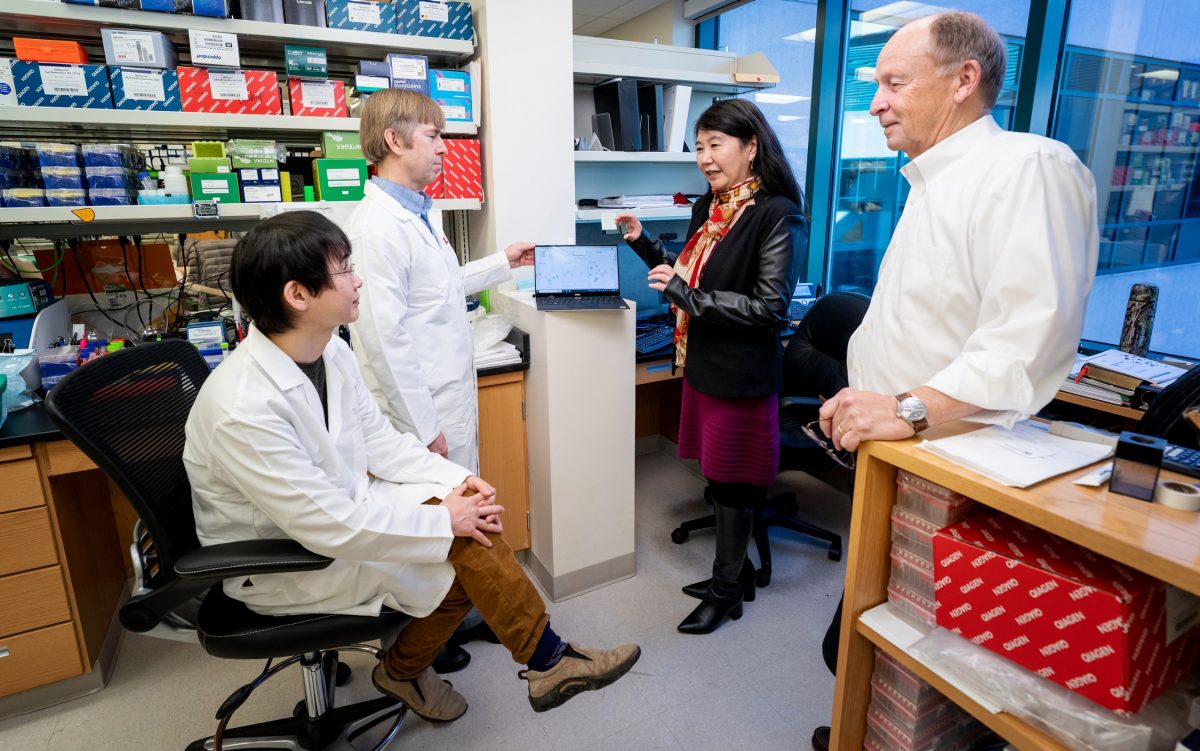
(L to R) First author Kohei Hagiwara, M.D., co-corresponding authors John Easton, Ph.D., Jinghui Zhang, Ph.D., St. Jude Department of Computational Biology; and Leslie L. Robison, Ph.D., emeritus member and former St. Jude Department of Epidemiology and Cancer Control chair.
Childhood cancer survivors age biologically faster than their peers, developing chronic health conditions much earlier in life. Scientists at St. Jude Children's Research Hospital uncovered associations between cancer treatments and an accumulation of acquired mutations in subpopulations of blood cells. This accumulation is an indicator of accelerated aging called clonal hematopoiesis. They found these associations using the most well-characterized group of long-term survivors of pediatric cancer, the St. Jude LIFE Study cohort. The findings were published today in Cancer Discovery.
Clonal hematopoiesis is a phenomenon marked by expansion of blood cells initiated by a single mutated cell. Clonal hematopoiesis is associated with aging and can confer an increased risk of blood cancer and death. In clonal hematopoiesis, the mutated cell's descendants, which are genetic clones of itself, are overrepresented in a person's blood. Clonal hematopoiesis becomes more prevalent as people age. Prior to this study, it was unclear how much childhood cancer treatments contributed to this effect in long-term survivors.
"The biggest discovery of the study was finding the association of treatment with the presence of clonal hematopoiesis in the St. Jude LIFE cohort," said co-corresponding author Jinghui Zhang, Ph.D., St. Jude Department of Computational Biology chair. "We were able to separate the effects of normal aging from the effects of therapy on clonal hematopoiesis."
Finding a mutational signature with a deep sequencing magnifying glass
Certain chemotherapies will mutate DNA in a specific way. Such a pattern can leave a fingerprint or signature for that treatment. The St. Jude researchers used deep sequencing data from St. Jude LIFE, a long-term follow-up study of childhood cancer survivors, and combined it with the known treatment exposures to look for these mutational signatures.
This is the first study to investigate 39 genes related to clonal hematopoiesis by deep sequencing a large cohort of pediatric cancer survivors (2,680 patients) years after the initial cancer diagnosis (median follow-up of 23.5 years post-diagnosis). St. Jude has collected samples from these individuals over the course of several years. The scientists used the rich longitudinal data to associate clonal hematopoiesis with a specific set of mutations over time.
The computational model they developed from deep sequencing data acted as a magnifying glass to see connections to clonal hematopoiesis more clearly. Next, the group characterized the genome-wide mutations at the single-cell level, which aided in the identification of changes in DNA associated with chemotherapy. The group then employed single-cell assays to classify thousands of blood cells from multiple St. Jude LIFE patients to determine which type of blood cell contained an altered DNA sequence. They found the mutation was enriched in T cells, an important white blood cell population of the immune system.
"We found a specific chemotherapeutic signature associated with survivors of Hodgkin lymphoma," said co-corresponding author John Easton, Ph.D., St. Jude Department of Computational Biology. "In these survivors, we determined that T-cell clonal hematopoiesis is associated with mutations in the major signaling protein STAT3."
The researchers determined that the drug procarbazine, a common treatment for Hodgkin lymphoma, generated the mutational signature associated with increased clonal hematopoiesis amongst survivors of the disease. These results suggest that physicians should preferentially use an alternative treatment, which is now available, that has a better long-term impact. From a broader perspective, the study showcases the forefront of genomic research studies in survivorship.
"The Hodgkin survivors are in many ways the vanguard of survivorship late effects research in childhood cancer," said co-corresponding author Leslie L. Robison, Ph.D., emeritus member and former St. Jude Department of Epidemiology and Cancer Control chair. "They are the group that had high cure rates very early on following aggressive therapeutic approaches. As those Hodgkin survivors are aging and getting old, they are the group that might best inform what we should expect to see in other survivor populations."
The research demonstrated how certain discoveries are only possible with long term follow-up research, highlighting the value of St. Jude LIFE in generating insights that can lead to therapy optimization with reduced toxicity. Additionally, the data generated from this study can be accessed through another unique resource, the St. Jude Cloud, where other scientists can get the data and perform their own analyses.
Authors and funding
The study's first author is Kohei Hagiwara, of St. Jude. The study's other authors are Sivaraman Natarajan, Zhaoming Wang, Haseeb Zubair, Heather Mulder, Li Dong, Emily Plyler, Padma Thimmaiah, Xiaotu Ma, Kristen Ness, Zhenghong Li, Daniel Mulrooney, Carmen Wilson, Yutaka Yasui and Melissa Hudson, all of St. Jude.
The study was supported by grants from the St. Jude Cancer Center Support (CORE) Grant (P30 CA21765), the National Institutes of Health (R01 CA216345, R01 CA216391 and U01 CA195547 1 and ALSAC, the fundraising and awareness organization of St. Jude.
Read the full text of the Cancer Discovery article:
Cancer Discovery, published February 8, 2023






